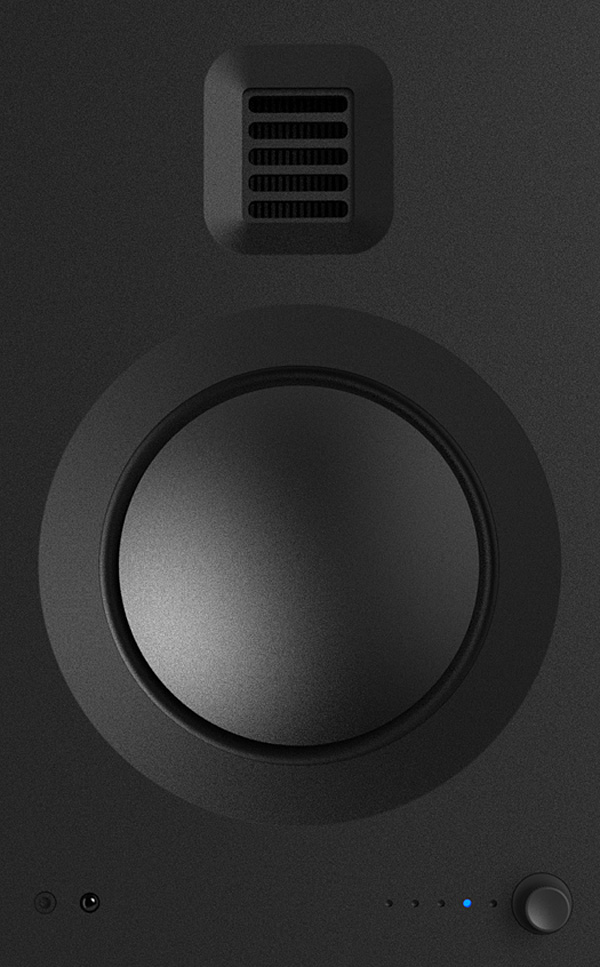Kanto TUK Powered Bookshelf Speakers Page 2
The Kantos proved to be very near perfection in the vocal ranges. Jeff Tweedy's dry, vestigial-rasp voice was beautifully open and defined on the Wilco cut, and a tour through my usual rotation of "gotcha" voices—singers like James Taylor and Mark Knopfler, whose baritones tend to expose peak/dip colorations or boxy resonances— turned up precisely nothing. The TUK's upper-bass-to-midrange smoothness and openness were very impressive.
 Turning to the opposite end of the spectrum, the diminutive TUK's ability to produce reason- ably well-defined low frequencies down to below 40 Hz let it easily propel unimpeded bass content with nearly all rock, jazz, and pop. As just one example, when listening to the jazz track "When Will the Blues Leave?" by Bley/Peacock/Motian (Quobuz stream), Gary Peacock's standup bass sounded solid, woody, and intense as it walked energetically from high to
Turning to the opposite end of the spectrum, the diminutive TUK's ability to produce reason- ably well-defined low frequencies down to below 40 Hz let it easily propel unimpeded bass content with nearly all rock, jazz, and pop. As just one example, when listening to the jazz track "When Will the Blues Leave?" by Bley/Peacock/Motian (Quobuz stream), Gary Peacock's standup bass sounded solid, woody, and intense as it walked energetically from high to
low and back, its obviously enhanced bottom octave or so (amplified, I suspect) coming across as profoundly big. Over that, Motian's characteristic dancing cymbals floated with the kind of easy air and unforced scintillation I usually associate with far higher-end designs.
Even a bass-challenging track like Donald Fagen's "Morph the Cat" (24-bit/96kHz FLAC), which hits a C-sharp just below 35 Hz, was reproduced surprisingly effectively, without any doubling, rattling, fizzing, or other rude noises. Go much lower and the TUKs dropped off precipitously, producing little from the sub-bass of a track like Dido's "Look No Further" (Tidal stream). But that doesn't count as a knock against a speaker not much bigger than a gallon of milk. And the Kantos could deliver high-quality sound at quite loud levels, too— surprisingly so, though not
so surprising to me as I know what well-engineered active speakers, even smaller ones like the TUKs, can be made to do. However, at excessive volumes, by which I mean levels louder than I usually wish to listen at, the pair became discernibly "tizzy" as the little ribbon tweeter harshened—presumably, from slight overload of its magnetic system.
With the TUKs on my stands at about 30 inches from the front wall to the baffles, overall bass balance, though notably even and smooth, was rich, perhaps to a fault. Moving them out another 10 inches or so tightened things up a good bit. Was bass still a tad emphatic? Yes. But with response so otherwise well balanced and uncolored, I wasn't complaining. Who doesn't like bass?
One consequence of the Kanto's notable clarity seemed to be a slight lessening of soundstage depth. Instruments and voices were tightly located left-to-right, but the sense of stage depth and front-to-back placement on good live recordings, like the Bley/Peacock/ Motion track cited above, or an old favorite live recording of Milhaud's chamber/jazz la Création du Monde seemed just a bit foreshortened compared with my everyday (and much more costly) reference.

Hooking up my turntable to the Kanto's phono jacks confirmed the efficacy of the all-in-one design. LPs sounded exactly as expected: good ones, excellent; poor ones, not so much; and beat-up ones, dull and pop-crackly. Does the TUK's on-board moving-magnet phono preamp present a challenge to any high-end outboard phono stages? I'm not a vinyl devotee, so I don't know, but records played on the Kanto sounded just fine to me.
I tested the TUK's headphone output on three different sets of 'phones with good results in each case, and adequate, though not overly ample, level. Interestingly, I found myself cutting bass by a click or two with two of the three headphone models, which is not something I'm accustomed to doing. I also tried the TUK connected to my SVS PC12+ subwoofer and was able to achieve a suitable blend with the sub's lowpass set to 80 or 100 Hz.
Ergonomics
I found Kanto's supplied remote mostly easy and intuitive, considering that its only day to day commands are volume, input, and tone. That said, with no visual feedback I also found the volume control "ballistics" a little tricky: single presses produced little or no audible change, while holding down the plus key causes a very slow, and then suddenly very fast, increase. The TUK also provides no visual reference for the tone settings on either speaker or remote, so this, too, is strictly a by-ear affair. But Bass and Treble each get a Reset key, so you can instantly return to flat. The remote's transport buttons indeed controlled play/pause and skip on my iPhone when paired for Bluetooth—a nice little extra. The fixed 80-Hz sub crossover confirms engagement only via a subtle LED blink, but Kanto fortunately makes the filter revert to full-range every time the power is removed.
So, if your TUK speakers ever sound unaccountably thin, just unplug them for a few moments. Another nifty feature: either speaker can be "left," which eases hookup and placement concerns. This setting has the same power-cycle revert default as the crossover, so if the violin section suddenly appears on the wrong side of the stage, see above. One last, thoughtful feature: the tone settings by default affect all inputs, but you can individualize these through some owner's manual-guided button-pushing.
Conclusion
Kanto's TUK proved itself to be exactly what its maker claimed: an effective, affordable, all-in- one entrée to serious audio reproduction. If I were contemplating life in a dorm room, or perhaps a small apartment, I would buy a pair in a heartbeat and consider it a steal.




























































